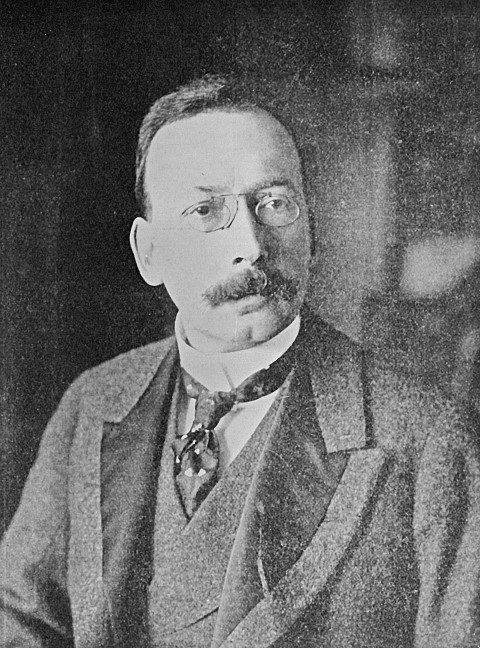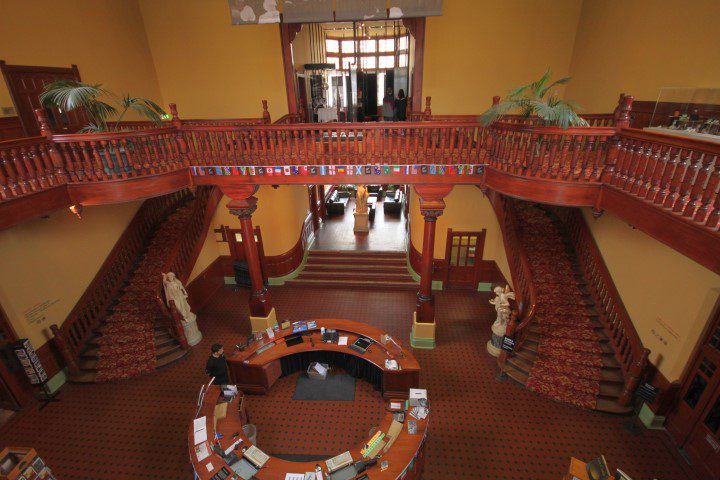Stewart Cameron
Halifax, Nova Scotia, Canada

Ref: 1/2-037890-F. Alexander Turnbull Library,
Wellington, New Zealand.
Used with permission.
Dr. Arthur Stanley Wohlmann played a pivotal role in the history of New Zealand despite his great project being a calamity. Even his discipline lost stature, yet Wohlmann himself retains a positive reputation in history.
In the late 1800s, the British colony of New Zealand was promoting tourism as it was establishing an economy. The abundant thermal springs and geysers of the North Island were especially popular with visitors. The town of Rotorua had many hot pools, which had been bathing spots for the native Maori people for hundreds of years.
There had been some earlier attempts to develop medical bathing at Rotorua, but none had lasted. A pavilion built in 1882 to house one bath fell down after only two years. This was partly because not all baths were particularly salubrious. Many released noxious gases, including hydrogen sulfide, which were corrosive and even caused the deaths of some unwary bathers.
Nevertheless by 1894 Rotorua had become the most popular of spas in the country, coinciding with the peak of the discipline of balneology: the medical science of bathing.
The ancient Greeks and Romans had enjoyed bathing and considered it healthful. By the Middle Ages, however, bathing had fallen out of favor, often considered dangerous and even sinful.1 The popularity of therapeutic baths rose and fell during the Renaissance.2 In the 16th and 17th centuries, visiting a spa became popular among royalty and the rich. It did not take long before doctors also became involved, setting up shop at popular spas to recommend specific water treatments to the wealthy. The discipline of balneology was born.
By the end of the 18th century there were several books on the subject. A journal was created and the British Balneological Society was established. Wealthy people paid good money to “take the cure” at the spas that dotted Europe and the British Colonies. Bathing became a distinction between the upper classes and the common folk.
When New Zealand decided to build a world class medical bath facility to attract those wealthy patrons, they called on Dr. Arthur Stanley Wohlmann (Figure 1). He had impeccable credentials, having trained in London at Guy’s Hospital and worked as a balneologist at the spa in Bath.
Wohlmann conceded that his specialty was “yet in its infancy” and was “almost untaught in the medical schools.” It was admitted that there was a “good deal of healthy skepticism” about balneology.3 Doubts notwithstanding, Wohlmann was hired by New Zealand in the late 1890s to fill a new post as “Government Balneologist.” His task was to oversee the construction of a new spa at Rotorua and run it. The project was under the auspices of the Department of Tourist and Health Resorts, its priority being tourism first and health second, and Wohlmann himself acknowledging the dual purpose when he wrote “The baths of Rotorua are designed expressly to cater for the needs of two distinct types of bathers—those who come for pleasure and those who come for ‘the cure.’”4
To accommodate to the needs of the wealthy health tourist, Wohlmann worked with an architect to create an imposing facility of “European standards.” It would use rare local woods and imported ceramics, displaying classically themed marble sculptures to give the facility the luxury the patrons would expect (Figure 2).

Image copyright Stewart Cameron
Considerable innovation was necessary because of many problems. As digging into the ground released toxic gases from the soil, the builders responded by creating a crawlspace instead of a basement. They used local pumice to create pre-fabricated reinforced concrete to erect the structure. When the sulfurous fumes blackened the lead pigments in the original paint, new finishes had to be used. Wohlmann had several disagreements with his team, but the spa finally opened in 1908, although the construction of one whole wing was abandoned.
Wohlmann had some progressive ideas for his time. He wrote “acute disease tends to monopolize the attention of our profession . . . when a case degenerates into the chronic stage interest speedily declines, and the fight with disease is carried on in but half-hearted fashion.”5 Wohlmann felt the waters of Rotorua would be a boon in chronic disease management. He wrote “the change of treatment to a health resort will often lift the sufferer out of the rut, stimulate his jaded constitution to fresh efforts and start anew the interrupted progress of recovery.”6
Yet, he also held some strange ideas. He was convinced that attention to the exterior of the body effected changes in the viscera, e.g. stimulating the hands could influence the health of the lungs, and a cold douche to the lower spine would influence the stomach.7 Douche massage was claimed to be effective for treating “atonic conditions of the viscera.”8 He felt that most patients seeking the cure at a spa suffered from “dyspepsia,” and was ever vigilant for underlying “hysteria,” “neuroses,” and “neurasthenia.” He felt that smoking tobacco had some merit and recommended minimizing the consumption of water at meals. He wrote that it was unwise to restrict red meat and wine for the “anaemic asthenic gouty patient.”9 Besides bathing, he recommended drinking the mineral spring water, especially to relieve “engorgement of the liver” and treat hemorrhoids. Inhalation of the vapors and steam baths were also endorsed. He did admit that exposure to the hydrogen sulfide could predispose some bathers to “fainting,” and also acknowledged that some baths might produce a “very irritating and obstinate papular rash” and even intractable skin ulcers.
Wohlmann prescribed his resources with some rather liberal indications. For instance, he recommended drinking one particular spring water for “flatulent dyspepsia . . . intestinal auto-toxication and gout.”10 He felt it was also beneficial in “kidney mischief.”11
The technique of Aix Massage (a rubdown given while being showered with warm mineral water) was recommended for “stiffness and local wasting as a result of gout, rheumatism or injury” as well as “spinal curvature and clubfoot.”11 The newly discovered x-ray was used to treat skin conditions, and some baths were electrified with current to assuage nervous debility and exhaustion. He recommended electric current to treat pruritis of the vulva and anus and described “excellent results.”12
The “Plombiere’s Douche,” a type of enema, was claimed to be effective for colitis and “arthritic diseases of the colon.” For “obstinate joint effusions” the Greville hot air baths were prescribed, wherein the limb was placed in a cabinet with air heated to 300-500 degrees Fahrenheit. Wohlmann also claimed to have cured hundreds of cases of eczema, psoriasis, and even gonococcal arthritis with balneotherapy.

Image copyright Stewart Cameron
Despite the wide variety of treatments offered, the expected rush of paying customers never materialized. Also, expenses were unexpectedly high. While Wohlmann had predicted great savings in maintenance costs, they ballooned. Within the first year, corrosion was noted in the plumbing and it all had to be replaced. The steam and vapors also ate away at the ventilation system and roof. There were some leaks, the plaster swelled, and the adhesive holding the ceramic tiles gave way. In one area part of the ceiling collapsed.
If Wohlmann was discouraged it did not show. He pressed for more repairs. He travelled the country making an inventory of other springs and hot pools. He published a book for the public entitled “The Mineral Waters and Health Resorts of New Zealand” and another for medical professionals on correct use of the mineral waters. In the latter he reported a detailed analysis of the various waters, cataloguing their osmotic pressures, the content of their dissolved minerals and gases, and even their radioactivity. He summarized thousands of cases that had been treated at the spa.
Then, he faced a threat that he had not anticipated: the First World War broke out, and all things German became unpopular in the British Empire. Wohlmann was hounded to the point that he moved out of his residence near the baths, retreating to the edge of town. He even changed his name to Herbert. In 1919 he left the country forever.
New balneologists were hired. They worked hard to publicize the facility. Returning soldiers were rehabilitated there, but the hoped-for profits never came. Meanwhile back in England, Dr. Herbert set up a private office practice in London’s Kensington district. He died in 1944 at age seventy seven.
It is probably just as well that he did not live to see what happened to his project. The facility was turned over to the Health Department, and there was little interest in what now was a white elephant. In a Health Department Report in 1949 the director of Physical Medicine Dr. G.A.Q. Lennae declared that [promoting] “the mineral waters of Rotorua as miraculous cure-alls could not be condoned.”13 The report continued “The old fashioned spa conception . . . had to be abandoned” and Dr. Lennae called for “a more rational and scientific outlook.” The decline of the building accelerated. A visitor recalled the 1959 structure as “ blackened—a place out of hell . . . a decayed monster.”14 In 1963 the once elegant facility was turned over to the city of Rotorua. Within three years the medical equipment and staff were out of the facility.
Yet, this was not the end for the building. The city refurbished it, turned one section into a museum, and added an art gallery. The artifacts from the spa project proved of great interest to the public, and soon the site was admitting thousands of paying visitors. It was so well attended that the city built the additional wing called for in the original plans and expanded the galleries (Figure 3). The facility eventually became what the first politicians had envisioned: a major tourist attraction.
The Rotorua Museum states that Dr. Wohlmann/Herbert’s obituary did not at all mention his work in New Zealand. One might conclude he had not recalled his tribulations there with much fondness. His great project had ended in disarray, his discipline was losing stature to advances in medical and surgical therapy, and he had been personally hounded from his home. Rotorua, however, remembers Dr. Wohlmann. His vision, perseverance, and innovation remain very much preserved in the facility he built and in the exhibits it contains.
References
- Katherine Ashenburg The Dirt on Clean, an Unsanitized History (Toronto: Alfred A. Knopf Canada, 2007)
- A van Tubergen, S van der Linden, A Brief History of spa therapy. Ann Rheum Dis 2002;61:273-275
- A.S. Wohlmann, The Mineral Waters and Spas of New Zealand (Wellington: Government Printer, 1914) Preface
- A.S Wohlmann The Mineral Waters and the Health Resorts of New Zealand (Wellington: New Zealand Department of Health and Tourist Resorts, 1905) p. 42
- A.S. Wohlmann, The Mineral Waters and Spas of New Zealand (Wellington: Government Printer, 1914) p. 9
- A.S Wohlmann The Mineral Waters and the Health Resorts of New Zealand (Wellington: New Zealand Department of Health and Tourist Resorts, 1905) p. 43
- A.S. Wohlmann, The Mineral Waters and Spas of New Zealand (Wellington: Government Printer, 1914) p. 30
- Ibid, p. 78
- Ibid, p. 47
- A.S Wohlmann The Mineral Waters and the Health Resorts of New Zealand (Wellington: New Zealand Department of Health and Tourist Resorts, 1905) p. 76
- Ibid, p. 43
- A.S. Wohlmann, The Mineral Waters and Spas of New Zealand (Wellington: Government Printer, 1914) p. 34
- Ian Rockel, Taking the waters: early spas in New Zealand (Wellington: Government Printing Office, 1986) p. 45
- http://www.rotoruamuseum.co.nz/things-to-see-and-do/taking-the-cure/the-spa-ethos/ Accessed Feb 1, 2014
, MD, FCFP, MAEd, is an Associate Professor at Dalhousie University who teaches and practices Family Medicine in Halifax, Nova Scotia. He has published in the field of medical education, information technology, and humor. He worked as a general practitioner on two occasions in New Zealand, where he was inspired by the story of Dr. Wohlmann.
Highlighted in Frontispiece Winter 2015 – Volume 7, Issue 1

Leave a Reply